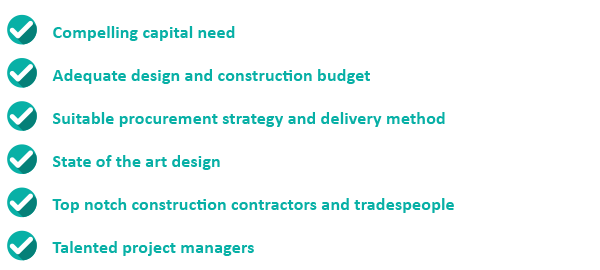




You’ve checked the boxes and got everything you need for a great construction project…but the key project leaders talk past each other or do not talk at all, problems fester for months without decision or action, letters are exchanged, change orders mount, and your team never catches up. The project finishes late, over budget, and you’re in claims litigation for years. Why?
The construction process is full of well-worn and tested processes, stable regulations, universally accepted and legally sound contract documents, and rapidly improving technology. Management of large construction programs has also evolved to take advantage of business school lessons and industry best practices. But if you’ve been on projects like the one above, you might have been missing an important component – partnering. You probably have a reaction when you hear the word, however, no matter how you feel about partnering, you might want to take another look.
With partnering, often guided by a skilled facilitator, project stakeholders proactively decide as a project team what is important and how they will operate together and create an environment conducive to candor and transparent communications. In the face of repeated results like the one above, owners of some of the largest construction portfolios in the federal government, including the US Army Corps of Engineers, State Department Overseas Building Operations, the Architect of the Capitol, and Naval Facilities Engineering Systems Command (NAVFAC), are reinventing and reenergizing their partnering programs.
Partnering is not an event or a philosophy or even a method per se. Construction project partnering has been around for most or all our professional lives, and it has moved into and out of fashion at least three times in my memory, each time with a different flavor. Today’s partnering is more concrete than you might remember from the days of Myers-Briggs and three-day teambuilding and trust retreats. It deals with governance, accountability, decision support, and risk management.
The owners listed above have focused their partnering policies on optimizing the connections between project stakeholders, enforcing discipline in communications, and using feedback loops among leaders at the various levels of project oversight and governance, in addition to establishing and committing to the shared goals at the heart of every project. Partnering is not a soft skill, rather, the creation of an effective working environment among the key project leaders is an often-essential element of successful project management.
Partnering for the $600 million additions/alterations to the Walter Reed National Military Medical Center now underway at Naval Support Activity, Bethesda, Maryland, which two MBP colleagues and I are facilitating, is based upon the guidelines outlined in the October 2020 NAVFAC Partnering Instruction. It engages three tiers of leadership from senior executive to field-level and incorporates a robust bi-weekly risk management protocol. The seven project stakeholder organizations rate the effectiveness of their partnership every quarter for safety, quality, schedule, budget, teamwork, communications, and commitment to the project goals, and offer suggestions for improvement. From the outset, this project team came to the project equipped with all the elements for a successful project listed at the top and jointly developed the all-important team operating instructions not long after construction award.
Through the use of partnering, they are also solving problems at the lowest level, looking ahead to identify risks over the horizon, building agility into their team decision-making processes, and making decisions in the best interest of the project. They are talking to each other about what they need from each other and what isn’t working as well as it could be. Now that’s everything you need for a great construction project.
Related reading: A Modern-Day Look at Partnering: 5 Strategies That Will Reduce Conflict and Improve Project Outcomes
Comments